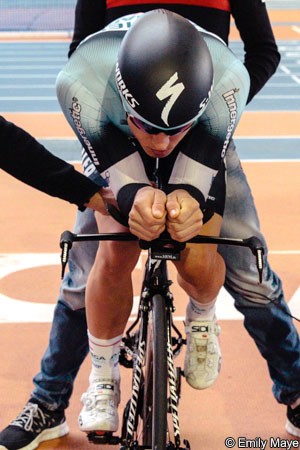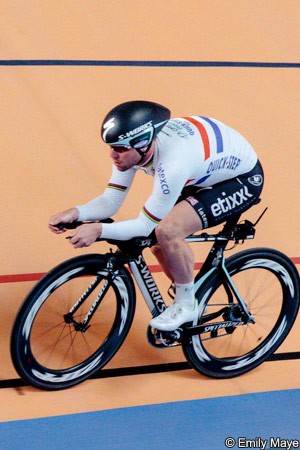Team works to find advantages in wind tunnel and in Valencia velodrome
 After doing extensive measurement, analysis and adjustment last month in the wind tunnel at Specialized’s headquarters in Morgan Hill, the team and Specialized’s bike fit technicians have collaborated further in Valencia’s velodrome to transfer theory into practice.
After doing extensive measurement, analysis and adjustment last month in the wind tunnel at Specialized’s headquarters in Morgan Hill, the team and Specialized’s bike fit technicians have collaborated further in Valencia’s velodrome to transfer theory into practice.
While the wind tunnel work helped establish the positions and bike setup which is theoretically the fastest possible, the ideal solution must also take account of the need to put out high power and also to remain relatively comfortable.
As a result, riders such as Mark Cavendish and Michał Kwiatkowski [both pictured] spent time in Valencia trying to finalise the best balance.
“Last month we had testing in the Specialized wind tunnel at Morgan Hill,” OPQS Sport & Development Manager Rolf Aldag explained. “On the track, it’s a little bit different of a scenario. It’s still all about positioning for the time trial bikes, but a different environment.
“With Specialized we had a structured plan for these guys in mid-November, and now we’re back on the track to confirm what we had seen in the wind tunnel. It’s always a learning process. You can never say you are done and we don’t have to do this anymore. There is always something more to improve on and work with.”
In that past some riders in the peloton have made the mistake of finding the best wind tunnel position, in terms of aerodynamic drag, and simply adopting that without considering that it is also crucial to be able to pedal the bike well.
Aldag said that the big goal of the Valencia testing is to find the best solution between the two.
“It’s not only comfort, but the ability to use all of your physical performance while also trying to be aerodynamic,” he explained. “For example, we talked about hip angles. If you close the angle too much, the muscles won’t really perform. Details like that make it really interesting because you have to find a way to make each rider super-fast, but also put them into a position that is rideable. Sometimes one makes the other impossible.
“This is where we need a lot of expertise and to learn, you need the kind of support we get from Specialized and its Body Geometry Fit experience.”
 He said that riders such as Cavendish have already spent a lot of time on the track and have done good work in the past on their positions. The Manxman is one of the lowest, most aerodynamic riders in the bunch, and this has helped him notch up numerous victories in bunch sprints.
He said that riders such as Cavendish have already spent a lot of time on the track and have done good work in the past on their positions. The Manxman is one of the lowest, most aerodynamic riders in the bunch, and this has helped him notch up numerous victories in bunch sprints.
Other riders have never undergone the same tests and therefore have the biggest margin for improvement. However Aldag points out that the best position this week for the riders is not necessarily the best at a later point; the body can adapt and further work can be done to move even closer to the ideal position.
“It’s a lot of work for small gains, but it’s definitely worth it to do these kinds of tests,” he said. “Especially when you do it for the guys who have never been tested, and we had participants who hadn’t.
“Some of these guys it’s as simple as them not being flexible enough to get more aerodynamic. But we can train that, so it is better to find that out now, find their limitations, and train where their needs are so we can come back and find a more aerodynamic position for them in the future.”
He said that the importance of doing things as well as possible in this area is exemplified by the extremely tight margins in the last two world championships.
“In 2012 we won the UCI TTT championship by about three seconds. In 2013 the difference was less than a second. So, with those fractions of time differences, we can be happy this kind of stuff is done.
“We don’t have to do all of this hard work on our own and start from scratch with our riders in the time trial. We have experienced people to help us, and it really helps give us a bit of an edge.”